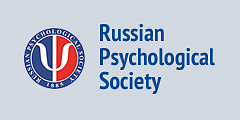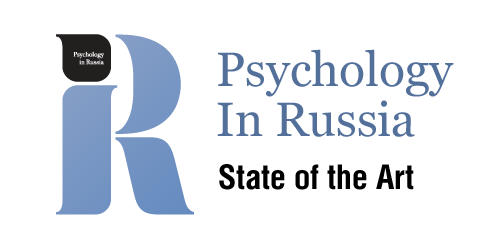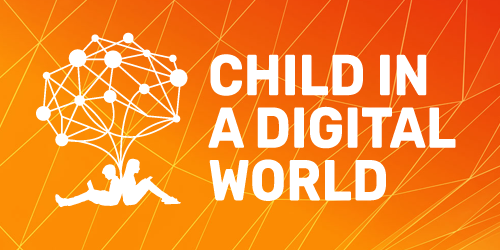Articles
-
Longitudinal study of mixed emotions in 5-6 and 7-8 year old children: the cognitive aspectLomonosov Psychology Journal, 2023, 1. p.152-174Read more1644
-
Background. This article presents data from a longitudinal study of understanding mixed emotion in preschool and primary school-age children, as well as the relationship of emotion understanding to the development of thinking. Understanding mixed emotions is viewed as children's ability to recognize and interpret emotions consisting of two simultaneous emotions of different valences. In contrast to the majority of other works following Piaget's theory, our work, follows the structural-dialectical approach and examines how the understanding of mixed emotions is connected not only to formal operations, but also to dialectical actions which allow us to look into the way a child forms the unity of two opposite emotions.
Objective of the study was to analyze how understanding mixed emotions develops in children aged 5-6 and 7-8 and to assess the nature of changes in the relationship between understanding mixed emotions and indicators of cognitive development in these two age groups.
Sample. Data were obtained by diagnosing 80 children, including 42 boys (52.5%) between 2019 and 2022.
Methods. Preschoolers’ understanding of mixed emotions was assessed using a set of tasks consisting of three stories whose characters experienced atypical emotional experiences (Veraksa et al., 2022a). To diagnose the formal-logical thinking, the Probability, Scale and Cylinder methods (Piaget, Inhelder, 1951; Piaget et al., 1948), which were part of the classic Piaget tests, were applied. The development of dialectical thinking was assessed with the techniques “Drawing an Unusual Tree”, “What can be at the same time?”, and “Cycles” (Veraksa et al., 2022b).
Results. Analysis revealed that children in the first grade were more successful in completing mixed emotion tasks than children in the older preschool group. It was found that the success in comprehension tasks for mixed emotions among older preschoolers and first graders was related to the development of multiplication operations (formal-logical operations) and operations of mediation, serialization, and reference (dialectical operations).
Conclusion. The peculiarities of the connection between the understanding of mixed emotions and the development of formal and dialectical thinking in children aged 5-6 and 7-8 were revealed.
Keywords: understanding mixed emotions; naming emotions, formal-logical thinking; dialectical thinking; logical operations; preschool age; younger school age Keywords: 10.11621/vsp.2023.01.07
-
-
Dinamics of individual religiosity: constructing an empirical typologyLomonosov Psychology Journal, 2023, 1. p.121-151Read more1582
-
Background. The increase in migration flows and the general mobility growth in the modern world exacerbates the existing problems and causes a number of new ones in the sphere of interaction between cultures and religions. Former homogeneous in terms of cultural and religious background regions become multi-confessional and multicultural territories. Modern people are usually not so deeply rooted in traditional confessions in accordance, with their place of birth, but rather choose their religion themselves and can even construct an individualized religion based on the elements of various confessions. So, it is relevant to analyze individual trajectories of the religiosity development and the factors influencing them.
Objective. The study aims to qualitatively analyze individual religious and spiritual development and construct an empirical typology of religious trajectories in conditions of confessional and cultural diversity.
Methods. The qualitative research design was chosen. The method of semi-structured interview was used to collect data. Basing on the theory of faith development by J. Fowler, the concept of religious styles by H. Streib and the dynamic model by K. Reich we developed an analytical tool that combines macro- and micro-dynamics of individual religiosity. The study was carried out as a case study, cases were compared with each other and grouped into types based on the common features found in them. The final interpretation was obtained by integrating the interpretations of several researchers with different positions regarding religions.
Sample. In total, more than 40 semi-structured interviews with Christians and Muslims were conducted, transcribed and analyzed. The article presents 9 cases aged 20 to 38 (27.8±5.8; 6 women, 3 men) that represent two types.
Results. The article describes two (out of four developed in the study) types of individual religiosity dynamics: “religion as an individual choice” and “religion by inheritance”. The respondents of the first type, although they were christened in childhood according to the Orthodox tradition, were brought up in non-religious families. In their youth they choose a confession not typical for their parents, relatives and close friends. Their common feature is a certain distance from their peers during childhood and adolescence. The dynamics of their individual religiosity is associated with the search for their own “existential territory”, “spiritual home”. The respondents of the second type were brought up in religious families. The dynamics of their individual religiosity is determined by an intertwining of psychological factors (the need for separation from parents, overcoming infantile projections), and the actual religious (spiritual) search. The features, problems and challenges characterizing each of two types are analyzed.
Conclusion. The analytical tool proposed to construct typology makes it possible to explore the general psychological factors that determine the trajectories of development, without ignoring the importance of spiritual search. The results obtained in the study open up the room to conceptualize the ways of spiritual development in the context of two main processes related to each other — mastering tradition and separating from it.
Practical application of the results. The study describes the challenges and difficulties faced by young believers that may be helpful for psychological counseling for Christians and Muslims. The authors also hope that the article will be useful to those who are engaged in the fields of secular and religious education.
Keywords: religious development; religious styles; individualized religion; qualitative methodology Keywords: 10.11621/vsp.2023.01.06
-
-
To the question of eye movement analysis in the process of face perception. Perception of face attractiveness in people with different levels of emotional intelligenceLomonosov Psychology Journal, 2023, 1. p.100-120Read more1961
-
Background. Many studies have been devoted to the relationship between the perception of facial expression and emotional intelligence (EI). As a rule, the study of this issue involved the tasks of expression recognition with stimuli expressing strong basic emotions. However, differences in the success of expression recognition in groups with different levels of EI are not always significantly pronounced. This may be connected to the fact, that the recognition of basic expressions is too easy for subjects with both high and low EI scores. In order to conduct a more effective study of this issue, it is necessary to complicate the task of facial expressions recognition. To this end, one of the configurational effects of E. Brunswick stating that neutral faces with different configurations of facial features are perceived as emotionally colored, can be used. Under these conditions, a more adequate task is not to assess the success of expression recognition, but to assess the attractiveness of the face, which is closely related to the perceived facial expression. Thus, faces with positive expressions are more often rated as attractive, and vice versa. It is assumed that the study of the perception of neutral faces will reveal the features of the relationship between the perception of facial expression and EI.
Objective. The study is meant to explore the relationship between the perception of facial attractiveness and EI. It was assumed that subjects with different levels of EI would evaluate the attractiveness of neutral faces differently.
Sample. The experiment involved 49 people (20 men and 29 women, in the age range of 18–35 years).
Methods. Images of faces were presented on a monitor screen. Eye movements were recorded during stimuli presentation. The level of EI was assessed based on the results of the “Test of emotional intelligence” (TEI) (Sergienko et al., 2019). We calculated indicators of TEI for all branches of EI (the abilities to recognize, understand, manage, and use emotions), as well as the total score of EI. An analysis of face attractiveness scores as well as eye movement parametres (duration and number of fixations, duration of saccades) was carried out for two groups of subjects with high and low EI scores.
Results. It has been shown that there is an inverse correlation between the ability to recognize emotions and the average scores of facial attractiveness: subjects from the group with a high ability to recognize emotions rated the attractiveness significantly lower than the group in which this ability was less developed. Other EI ability branches (understanding emotions, managing emotions, and using emotions), as well as the total EI score, were not significantly associated with facial attractiveness scores. Various explanations of the resulting phenomenon were discussed. There were no significant differences in the duration and number of fixations, in the amplitude of saccades, as well as in the distribution of dwell time in the Areas of Interest (AOI) when looking at facial images between groups with high and low EI scores.
Conclusion. It was found that subjects with a higher ability to recognize emotions tend to perceive neutral faces as unattractive. Also, no significant differences were found in eye movement scores for groups with high and low EI scores. The absence of differences in eye movements in groups was most likely to be explained by weak relationship (or lack of relationship) between visual perception and such a high-level construct as EI.
Keywords: face perception; emotional intelligence; facial attractiveness; eye-tracking method; areas of interest; eye movement strategies Keywords: 10.11621/vsp.2023.01.05
-
-
Impact of external cognitive appraisal on intrusive memoriesLomonosov Psychology Journal, 2023, 1. p.79-99Read more1750
-
Background. Symptoms of compulsive repetition or “intrusion” (unwanted thoughts, flashbacks, images, disturbing dreams, nightmares) are often considered as a distinctive feature of post-traumatic stress disorder (PTSD). Cognitive models claim that PTSD symptoms are stimulated and become chronic due to an overly negative assessment of the traumatic experience and/or its consequences. The relevance of the study is due to the possibility of using external assessments as an early psychological aid tool.
Objective. The work aims to repeat the study of the University of New South Wales (Australia) on the degree of influence caused by various types of external cognitive assessment of obsessive memories on the frequency and intensity of their subsequent occurrence. The research targets to create a precedent in Russia for the study of traumatic stress in the laboratory.
Sample. 30 healthy psychology students participated in the study. Their stress level results did not exceed the level of normative values.
Methods. The main method of research was the experiment. Participants who received one of two preliminary instructions giving either a benevolent or a control assessment of obsessive memories were offered to watch a film with scenes of a real car accident. Having watched a traumatic film, the participants solved a problem on cognitive interference. Then the presence/absence and intensity of intrusive memories were recorded with the use of the Intrusion subscale of the Traumatic Event Impact Assessment Scale (IES-R) and two questions on the beliefs about intrusions.
Results. The study showed that watching a traumatic film causes an equally low level of obsessive memories in groups with positive and control instructions.
Conclusion. The results of two studies (University of New South Wales and Lomonosov Moscow State University) showed similar trends regarding the level of intensity of obsessive memories for groups with benevolent and control instructions. The study provides initial causal evidence that a maladaptive external assessment can enhance the occurrence of obsessive memories, despite the fact that a benevolent or control interpretation of symptoms has no such side effect. This observation is important to take into account when conducting psychoeducation. The practice of studying traumatic stress in the laboratory is evaluated as positive and recommended for use in Russia.
Keywords: intrusive memories; appraisals; cognitive models; extreme psychology; traumatic stress Keywords: 10.11621/vsp.2023.01.04
-
-
Perception of facial symmetry in upright and inverted facesLomonosov Psychology Journal, 2023, 1. p.54-78Read more1610
-
Background. The uniqueness of human face perception mechanisms and their variability has become a subject for extensive investigation and wide discussion in the recent decades. While now the concept that human face is perceived as a whole is taken as a fact, the same cannot be said about the structure and methods to measure holistic processing. In the present study the factor of symmetry is investigated as one of the possible aspects of configural processing of facial perception.
Objective. The aim of the study was to apply the inversion method to the investigation of how distortion of facial configuration perception impacts the rating of its symmetry/asymmetry.
Sample. 54 participants (24 female and 30 male) aged 18 to 68 (mean age 26) took part in the study.
Method. An intra-individual experimental design was used. Participants rated asymmetry of normally oriented and inverted face-stimuli on a five-point scale. To set the symmetry level, left eye and/or mouth regions were rotated around their fiducial points, there were three rotation angles for each feature region. Zero asymmetry faces were created by blending halves of normal and mirror images of the sample face-stimulus. The mean asymmetry subjective ratings were submitted to repeated measures analysis of variance and paired samples t-test.
Results. The study revealed significant differences in the asymmetry ratings of upright and inverted faces: normal upright faces with rotated features were rated as more asymmetric compared to inverted. Thus, we may conclude that symmetry perception is affected by inversion. It was also revealed, that the effect of the eye region and the lips region rotation were not equivalent: the higher the level rotation of the eye area was the more significant the difference between the rates of upright and inverted faces was, while rotation of the lips area did not result in higher difference between the rates.
Conclusion. The observed face-inversion effect in the perception of symmetry in facial stimuli suggests that (a)symmetry is a component of holistic (configurative) processing of human face perception. At the same time, the contributions of individual features to the overall facial configuration may differ.
Keywords: face perception; inversion effect; holistic processes; perception of the objects symmetry Keywords: 10.11621/vsp.2023.01.03
-
-
Identity of the information technology employees at different stages of professional developmentLomonosov Psychology Journal, 2023, 1. p.31-53Read more1655
-
Background. The present study of professional identity in the representatives of the information technology sphere is connected to the problem of directing modern specialists in the world of work which is rapidly changing and structuring the system of tasks in a new way. This requires the compliance of the psychological characteristics of an employee with computerised forms of job functions. The present work aims to research the features of professional identity among representatives of the information technology sector with different job experience in order to understand identity transformations during the professionalization in a more profound way.
Methods. The respondents are offered to fill in a questionnaire for social status data, the «Trust in technology» questionnaire (Akimova, 2020), semantic differentials for the evaluation of one’s personal qualities (Ginetsinsky, 1994), and the evaluation of oneself as a professional (Serkin, 2016).
Sample. It has totaled to 52 respondents studying and working in the field of Network and System Management, Innovation, Information Systems and Technologies related to the IT sphere.
Results. The data demonstrate two statistically significant trends in the development of the professional identity in the representatives of the IT sphere: the linear and the structural ones. The first trend shows the gradual entry into one's own specialty which is expressed in a consistent complication of ideas about oneself as a professional, the growth in confidence in one's own qualification, competence, and knowledge. The second trend is supported by restructuring the emerging ideas about oneself in the profession with the growth of real practical experience. Unlike students, in working specialists, it is expressed in «ignoring» personal characteristics and emphasizing professionally important qualities against the background of a growing confidence in technology and the degree of mastery.
Conclusion. The common feature of all the participants under the study is a positive attitude towards the introduction of information technologies and experiencing difficulties in mastering them. Professional identity of the respondents belonging to the same professional field which is characterized by rapid and diverse change has got features that distinguish different stages of professionalisation.
The results obtained make it possible to adjust the training programmes of IT specialists, taking into account the required competences as well as personal characteristics in order to approach the model of a specialist in the IT field.
Keywords: professional identity; IT-specialist; phases of professionalisation; digital technologies; confidence in technology Keywords: 10.11621/vsp.2023.01.02
-
-
Attitude to health and readiness for treatment in the situation of pandemicLomonosov Psychology Journal, 2023, 1. p.3-30Read more1565
-
Background. The COVID-19 pandemic has created an unprecedented model for psychology to explore the factors of adherence to recommendations, vaccination and protective actions in a situation of uncertainty.
Objective. The aim of the study is to reveal the relationship between attitudes towards health and readiness for treatment with adherence to recommendations and protective actions during the pandemic.
Methods. In November-December 2020, 523 respondents aged 18 to 65 filled in scales to assess their tendency for monitoring information about the pandemic, level of anxiety caused by the pandemic, vaccination, and protective actions during the pandemic, their readiness for vaccination, illness-related locus of control, self-efficacy in relation to treatment, “hypochondriac discourse”, as well as readiness for treatment and ideas on the specifics of medication.
Results. Respondents were more willing to actively comply with safety recommendations if they (1) had external locus of control in treatment — this effect was both direct and indirect, which implied higher pandemic anxiety; (2) believed in alternative medicine methods; (3) declared readiness for treatment; and also (4) valued health care as a resource conservation, which influenced compliance indirectly — through the higher pandemic anxiety. Adherence to self-isolation was higher with health being more important as a means of protection against risk (both direct and indirect effects) and indirectly (because of greater pandemic anxiety) as well as with an external locus of control for treatment. Vaccination readiness depended on the internal locus of control for illness causes, lower internal and higher external locus of control for treatment, and also distrust toward the medical system. At the same time, mistrust in the medical system was characterized by two indirect effects in relation to lower readiness for vaccination: on the one hand, distrust was associated with greater anxiety about the pandemic and therefore greater readiness for vaccination, and on the other hand, with greater anxiety about vaccination and therefore less readiness for it. Respondents reported better lifestyle control in cases of more pronounced self-efficacy, confidence in the importance of taking care of health and resorting to the methods of alternative medicine, as well as declared readiness for treatment. Outdoor trips were associated with self-efficacy and confidence in the importance of treatment with alternative medicine. Both of these effects were not explained by pandemic anxiety and vaccination anxiety.
Conclusion. Active and passive adherence to recommendations, as well as other ways of caring for health, depend differently on attitudes towards health and readiness for treatment.
Keywords: аttitudes to health; compliant behavior; anxiety; readiness to vaccination; actions in the pandemic situation Keywords: 10.11621/vsp.2023.01.01
-
-
IN MEMORY OF Tatiana Nezhnova (30.09.1947-10.12.2022)Lomonosov Psychology Journal, 2022, 4. p.276-278Read more1116
-
-
COPE-30: psychometric properties of the short version of the Russian-language inventory for coping strategies evaluationLomonosov Psychology Journal, 2022, 4. p.247-275Read more3519
-
Background. Numerous studies show that coping plays a big role in a person's adaptation to stressful situations and becomes the center of psychological practice, which dictates the need to develop a reliable, valid and compact tool that allows you to identify certain coping strategies.
The aim of the study was to develop a brief version of the Russian-language methodology for evaluating coping strategies (COPE-30) based on the full Russian version.
Methods. The survey included socio-demographic indicators and an assessment of life situation difficulty. The following methods were used: COPE, Hardiness Survey, Personal Self-Activation Inventory, "Subjective appraisal of difficult life situation" technique. Descriptive statistics, correlation analysis, exploratory and confirmatory factor analysis, three-way ANOVA, and two-way ANCOVA were used as data processing methods.
Sample. Data were obtained from an online survey (2021–2022). In total, the study involved 1395 people aged 18 to 76 years (average 32 ± 11 years, median = 31 years), of which 72,5 % were female, 24,6 % male, and 2,9 % other.
Results. Psychometric indices indicate good internal consistency of the COPE-30 scales. The results of the confirmatory factor analysis confirm the correspondence of the 15-factor COPE-30 model to the data obtained under different instructions. Three second-order factors obtained on the basis of 15 coping strategies correlate with all the characteristics of a difficult life situation, self-activation and hardiness. Women more often use the coping strategies "Concentration on emotions and their active expression", "Religion" and "Emotional social support", and men — "Humor", even when controlling for the difficulty of the situation.
Conclusion. The proposed COPE-30 inventory is a sufficiently reliable, internally consistent and valid tool for determining individual coping strategies. It has the same good psychometric characteristics as the full version of the inventory, and works well with situational and dispositional approaches.
Keywords: COPE, ; COPE-30, ; psychometric characteristics, ; coping strategies, ; coping styles, ; difficult life situations Keywords: 10.11621/vsp.2022.04.11
-
-
The role of conscious self-regulation in the dynamics of cognitive activity and cognitive engagement of students during the transition from secondary to high school: a longitudinal studyLomonosov Psychology Journal, 2022, 4. p.200-223Read more1808
-
Background. A decrease in cognitive activity and the occurrence of various deficits with a general decrease in a positive attitude to learning creates difficulties in learning during the transition to high school. It becomes important to identify regulatory resources for development of cognitive activity and engagement during the period before the 9th grade, as well as at the beginning of high school.
Objective — to identify the dynamics of cognitive activity and engagement during the transition from middle to high school and to assess the contribution of conscious self–regulation of eighth graders to this dynamic in the 9th and 10th grades.
Sample. 156 eighth graders aged M=13.88; SD=0.445. In the 9th and 10th grades, repeated examinations were carried out using the same methods. As a result, longitudinal data was collected at three points.
Methods. "Attitude to learning in middle and high school" (I.N. Bondarenko, I.Yu. Tsyganov, V.I. Morosanova). "Multidimensional scale of school engagement" (T.G. Fomina, V.I. Morosanova). Questionnaire of V.I. Morosanova "Style of self-regulation of learning activity, SRLAQ-M" (V.I. Morosanova, I.N. Bondarenko).
Results. We revealed between individual differences in the trajectories of cognitive engagement, but they were not revealed for cognitive activity. It is shown that in order to successfully maintain cognitive activity and engagement in high school, it is important to achieve the maximum level of their development in the 8th grade, a year before the state exams. Longitudinal analysis has shown that school engagement is more associated with conscious self-regulation in comparison with cognitive activity, which significantly depends on external factors. Conscious self–regulation, fulfilling its resource role, on the one hand, makes a direct contribution to the level of development of these characteristics, on the other hand, prevents their sharp decline in case of difficulties or temporary failures.
Conclusion. The development of conscious self-regulation in secondary school is able to compensate for the negative trends of falling cognitive activity and engagement that occur in high school students.
Keywords: cognitive activity; school engagement; conscious self-regulation; longitudinal study; high school students Keywords: 10.11621/vsp.2022.04.09
-
-
Methodological Foundations of the Psychology of Theatrical ActivityLomonosov Psychology Journal, 2022, 4. p.179-199Read more1559
-
Background. The article reveals acting as an activity, the definition of the method of "psychophysical actions" in the context of mastering the acting role as a process of development of higher mental functions of actors.
Objective. This article attempts to offer a psychological interpretation of the technologies of acting presented in the works of K.S. Stanislavsky, as well as his followers V.O. Toporkov, M.A. Chekhov, E.B. Vakhtangov, V.E. Meyerhold, M.O. Knebel, etc. from the point of view of L.S. Vygotsky's cultural-historical approach, A.N. Leontiev's theory of activity, psychological theories of communication and personality.
Methods. The authors of the article analyze stage communication and personality development during the development of the role from the point of view of the basics of social psychology and personality psychology, and also reveal scientifically based psychological interpretations of the acting profession as a conscious continuous activity aimed at achieving the credibility and organic existence of an actor on stage.
Results. The results of the theoretical analysis allow us to identify the mediation of theatrical activity by psychological patterns and technologies of analysis of the proposed circumstances of the role in the profession of the artist.
Conclusion. As a conclusion, a reasoned position is given on the need for scientific study of acting using the methodology of psychological science in order to develop the most effective method for the development of the acting profession as a process of formation of higher mental functions and the choice of adequate psychophysical actions in the proposed circumstances of the role.
Keywords: cultural-historical approach; higher mental functions; development of higher mental functions; method of psychophysical actions; psychology of the acting profession Keywords: 10.11621/vsp.2022.04.08
-
-
On the Relationship of Types of Social Creativity with Moral Identity and ToleranceLomonosov Psychology Journal, 2022, 4. p.159-178Read more1333
-
Antropova, M.Y., Meshkova, N.V. (2017). On the Situational Characteristics of Creativity in the Social Interaction of High School Students. Psychological-Educational Studies, 9, 3, 175–185. doi: 10.17759/psyedu.2017090318. (In Russ.).
Aquino, K.F., Reed, A., II (2002). The Self-importance of Moral Identity. Journal of Personality and Social Psychology, 83 (6), 1423–1440.
Bochkova, M.N., Meshkov, I.A., Meshkova, N.V. (2020). O svyazi moral'noi identichnosti i antiso-tsial'noi kreativnosti u kursantov. In YuA. Sharanov (eds.), Vasil'evskie chteniya — 2020: Aktual'nye problemy psikhologii pravookhrani-tel'noi deyatel'nosti: kontseptsii, podkhody, tekhnologii (Vasilyevsky readings — 2020: Actual problems of the psychology of law enforcement: concepts, approaches, technologies): materialy Mezhdunarodnoi nauchno-prakticheskoi konferentsii. Sankt-Petesrburg (23 aprelya 2020 goda). SPb.: Sankt-Peterburgskii universitet MVD Rossii, 68–71. (In Russ.).
Bochkova, M.N., Meshkova, N.V. (2019). Behavioral Features of Negative and Malevolent Creativity in Adolescents. Psychological-Educational Studies, 11, 1, 93–106. doi:10.17759/psyedu.2019110108. (In Russ.).
CTS. Creativity Testing Services. (2019). In M. Runco. ScienceSites: Websites for Scientists. URL: https://www.creativitytestingservices.com/products/ (date of retrieval: 26.09.2021).
Dumas, D.G., Strickland, A.L. (2018). From Book to Bludgeon: A Closer Look at Unsolicited Malevolent Responses on The Alternate Uses Task. Creativity Research Journal, 30(4), 439–450. doi: 10.1080/10400419.2018.1535790
Furnham, A. (2015). The Bright and Dark Side Correlates of Creativity: Demographic, Ability, Personality Traitsand Personality Disorders Associated with Divergent Thinking. Creativity Research Journal, 27 (1), 39–46. doi: 10.1080/10400419.2015.992676
Gong, Q. (2013). The relationship between negative creativity and moral personality. Master, Nanjing Normal University, Nanjing. URL: http://202.119.108.211/lunwen/list.asp?id=29472 (date of retrieval: 26.09.2022).
Harris, D.J., Reiter-Palmon, R. (2015). Fast and Furious: The Influence of Implicit Aggression, Premeditation, and Provoking Situations on Malevolent Creativity. Psychology of Aesthetics, Creativity, and the Arts, 9 (1), 54–64. doi: 10.1037/a0038499
Kapoor, H. (2015). The Creative Side of the Dark Triad. Creativity Research Journal, 27 (1), 58–67.doi: 10.1080/10400419.2014.961775
Kapoor, H., Khan, A. (2018). Creativity in Context: Presses and Task Effects in Negative Creativity. Psychology of Aesthetics, Creativity, and the Arts. Advance online publication. June 7.
Kornilova, T.V. (2010). Novyj oprosnik tolerantnosti k neopredelennosti. Psihologicheskij zhurnal, 31, 6, 74—86. (In Russ.).
Kosenkova, N.M., Meshkova, N.V. (2020). Self-esteem and types of creativity in adolescents: relationship and predictors. Vestnik Moskovskogo Universiteta. Seriya 14, Psykhologiya (Moscow University Psychology Bulletin. Series 14, Psyсhology), 2, 45–61. doi: 10.11621 / vsp.2020.02.03. (In Russ.).
Lee, S.A., Dow, G.T. (2011). Malevolent creativity: does personality influence malicious divergent thinking? Creativity Research Journal, 23 (2), 73–82.
Lyubart, T., Zenasni, F., Tordzhman, S. (2009). Psikhologiya kreativnosti. Moscow:Kogito-Tsentr, 215 p.
McLaren, R.B. (1993). The dark side of creativity. Creativity Research Journal, 6 (1–2), 137–144.
Meshkova, N.V. (2012). Intergroup Prejudice: Exploring Personality-Related and Situational Characteristics. Sotsial'naya psikhologiya i obshchestvo (Social Psychology and Society), 3, 1, 73–87. (In Russ.).
Meshkova, N.V., Debolsky, M.G., Enikolopov, S.N., Maslenkov, A.A. (2018a). Features of сreativity in social interaction among convicts who have committed self-serving and aggressively violent crimes. Psikhologiia i pravo (Psychology and Law), 8, 1, 147–163. doi: 10.17759/psylaw.2018080111. (In Russ.).
Meshkova, N.V. et al. (2018b). Adaptation of the Malevolent Creativity Behavior Scale. Psikhologicheskaya nauka i obrazovanie (Psychological Science and Education), 23, 6, 25–40. doi: 10.17759/pse.2018230603. (In Russ.).
Meshkova, N.V. et al. (2021). Predictors of Negative Creativity in Adults on the Example of Cadets. Psikhologiia i pravo (Psychology and Law), 11, 4, 90–108. doi: 10.17759/psylaw.2021110407 (In Russ.).
Okuda, S. (1991). Creativity and the finding and solving of real-world problems. Journal of educational assessment, 9, 45–53.
Pavlova, E.M. (2018). Model of Connections between Self-Esteem of Creativity and Intelligence, Tolerance of Uncertainty and Creativity. Psychology. Journal of the Higher School of Economics, 15, 1, 69–78. doi: 10.17323/1813-8918-2018-1-69-78 (In Russ.).
Runco, M.A. (1993). Creative morality: Intentional and unconventional. Creativity Research Journal, 6 (1–2), 17–28.
Runco, M.A. (2017). Hot topic 2. The dark side of creativity: Potential better left unfulfilled. In: J. A. Plucker (ed.). Creativity and innovation: Theory, research, and practice (Р. 49–59). Prufrock Press Inc., 2017.
Shen, W. et al. (2019). A Theoretical and Critical Examination on the Relationship between Creativity and Morality. Curr. Psychol., 38, 469–485. doi: 10.1007/s12144-017-9613-9
Soldatova, G.U. , Kravtsova O.A., Khukhlaev O.Ye. (2002). Psikhodiagnostika tolerantnosti (Psychology of tolerance). Psikhologi o migrantakh i migratsii v Rossii: inf. — analit byulleten' (Psychologists on migrants and migration in Russia: inf. — analyt bulletin). Moscow, 4, 59–65. (In Russ.).
Sternberg, R.J., Karami, S. (2021). An 8P theoretical framework for understanding creativity and theories of creativity. Journal of Creative Behavior, 56, 55–78. doi: 10.1002/jocb.516
Yip, J.A. et al. (2018). Trash-talking: Competitive incivility motivates rivalry, performance, and unethical behavior. Organizational Behavior and Human Decision Processes, 144, 125—144. doi: 10.1016/j.obhdp.2017.06.002
Zheng, X. et al. (2019). Will Creative Employees Always Make Trouble? Investigating the Roles of Moral Identity and Moral Disengagement. J. Bus. Ethics., 157, 653–672.
Keywords: social creativity; RWDT; prosocial creativity; antisocial creativity; moral identity; tolerance Keywords: 10.11621/vsp.2022.04.07
-
-
Social Success оf the Subject, Environment, Resources: Open Questions.Lomonosov Psychology Journal, 2022, 4. p.136-158Read more1456
-
Background. Historically changing ideas about the social success of a person, its specificity for representatives of different social groups, the expansion of the number of criteria for describing this phenomenon are becoming a permanently relevant scientific and scientific-practical problem. Associated with it is the phenomenon of «resources», in the explanation of which there are many open questions.
Object of the study is to study the spatial characteristics of the conditions of the social micro- and mesoenvironment as potential resources for the social success of subjects.
Methods. Historical-theoretical analysis, empirical research (author's method — questionnaire «Dynamics of professional life style»), methods of parametric statistics.
Results. An analysis of the survey data of 482 men and women aged 30–50 years (132 civil servants, 129 engineers and heads of departments of industrial enterprises, 221 managers) showed that higher assessments of the subjective significance of environmental conditions as “professional factors” , updated as resources, and the largest number of intercorrelations (with r ≥ 0.300) took place in the sample of civil servants; smaller ones — engineers and heads of departments of industrial enterprises and in a sample of managers.
Conclusion. Different conditions of the social environment are not equally significant for all people (persons of different sex, age, working in different fields of activity, having different experience, etc.) in their positive and negative impact on various manifestations of a person's success. Differences in environmental conditions, reflected as the specificity of the correlation pleiades for each group, indicate a non-separate effect on the success of the subject. Both individual conditions and their combinations represent relatively stable, integral and closed spaces. The conditions of the parental family, one's family, formed by a person's activity in the spheres of his interpersonal relations, in their subjective perception and subjective significance for different people, act as different, isolated spaces.
Keywords: social success; position; length of service; factors; conditions; environment; space; resources Keywords: 10.11621/vsp.2022.04.06
-
-
Professional Identity and the Satisfaction with the Professional Activities as Factors of Well-Being in the WorkplaceLomonosov Psychology Journal, 2022, 4. p.115-135Read more2193
-
Background. The present paper discusses the relevance of identifying oneself with a professionalism, the attitude to the profession and the role in the professional activity as an integral characteristic of the professional identity among representatives of different positions.
Objective. The identification of the relationship between the professional identity and satisfaction with professional activities (work process, working conditions, organization, choice of profession, etc.) and well-being in the workplace among representatives of various positions.
Sample. 11 558 employees (7,373 women, 63.8%, and 4,175 men, 36.2%) of a large energy company in the Russian Federation.
Methods. The participants filled in the questionnaire on the components of job satisfaction, the scales of the work involvement, the boredom at the workplace, the emotional exhaustion and initiative.
Results. The representatives of different positions are most satisfied with the benefits of their work for people, with their choice of profession and the profession itself and the labour process but they are less satisfied with the working conditions, payment, management and professional prospect. As for representatives of all the positions, involvement in the work, a low level of boredom and emotional exhaustion and initiative depend on not only the satisfaction with working conditions, payment, management and the professional prospect but also on the satisfaction with the choice of profession, the profession itself, its content, the benefit to people and the labour process.
Conclusion. Regardless of the position and satisfaction with working conditions, the satisfaction with the choice of profession, its content and benefits for people and the labour itself predict the involvement in work, initiative, a low level of emotional exhaustion and the boredom at work.
Keywords: professional identity; satisfaction with the profession; initiative; well-being in the workplace; emotional exhaustion; boredom; disorientation; digital technologies; the Covid-19 pandemic Keywords: 10.11621/vsp.2022.04.05
-
-
The Problem of Cross-Cultural Communication in Foreign ResearchesLomonosov Psychology Journal, 2022, 4. p.92-114Read more2035
-
Background. Intercultural interaction is the basis of positive development in the modern world. However, situations of conflicts and crises seriously disrupt cross-cultural communication. An analysis of the results of studies conducted in different countries and in different situations makes it possible to identify the psychological foundations for overcoming the negative consequences of violations of intercultural interaction.
Objective. Present the experience of researching the problem of cross-cultural communication.
Methods. Review of foreign literature.
Results. An analysis of modern research on the problems of cross-cultural communication has shown that, with the unconditional recognition of the characteristics of the cultures to which the studied groups belong as the leading determinant of the study, there is no socio-psychological typology of cultures, which does not allow building a predictive analysis of the interaction of representatives of different cultures. The studies describe various types of indirect, substitutive contact, the conditions of which allow establishing positive relationships, which is especially important in situations of protracted systemic political and economic crises. Researchers believe that objective conditions have developed for the functioning of intercultural psychology and that broad interdisciplinary cooperation is necessary to evaluate the effectiveness of the means of cross-cultural communication offered by psychologists.
Conclusion. The role of the semiotic approach in the study of cross-cultural communication is revealed. Since cultural differences are combined at the level of cultural codes, the semantic aspect of the combination of different cultures is a source of possible misunderstandings and contradictions. Mediated, substitute, indirect contacts of people help to overcome misunderstandings and create a basis for active intercultural cooperation. In this case, conditions are created not only for understanding the representatives of contacting cultures, but the understanding of all representatives of a different culture improves. The attitude towards representatives of cultures that do not participate in substitutive contact also improves. This effect is considered as intercultural competence.
Keywords: cross-cultural communication; groups ; situation of interaction; type of contact; interculturalism - "dialogue of cultures"; art; communication efficiency; interdisciplinary research Keywords: 10.11621/vsp.2022.04.04
-








